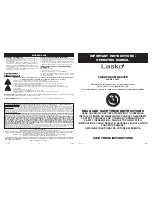
25
Servicing should only be performed by a Qualified Service Technician
FLAME SENSING CURRENT TEST
During the heating cycle the flame sensing current is normally greater than 8.0 μA with a clean Flame Sensor.
Over time the Flame Sensor can degrade and this will reduce flame sensing current. With heavier use, more
heating cycles/greater load, this will occur more quickly.
Measuring flame sensing current requires a test meter with a DC micro amp function, see "Tools Recommended"
on Page 2. The meter’s selector is set to DC micro amps. The two test leads from the meter are placed in
series with the flame sensing circuit. This can be done at the spade (male/female) flame sensing wiring
connectors. See Figure below.
To measure flame current disable water heating by turning off the Enable/Disable Switch located in the front
of the water heater and connect the test meter following the method shown in Figure below. Enable water
heating and ensure a call for heat is active - when the Control System energizes the 24 Volt Gas Control
Valve the meter will measure flame sensing current during normal operation.
Service Notes:
•
The most common cause of
Ignition Failure
lock out is a worn Flame Sensor. The Flame Sensor should
be inspected and cleaned anytime the measured flame sensing current is below 8 µA or the Burner has
been removed. Clean the Flame Sensor with ultra fine steel wool. DO NOT use a coarse abrasive material
such as sand paper. Inspect the ceramic insulator on the Flame Sensor for cracks, replace the Flame
Sensor if it is damaged.
•
An open flame sensing circuit caused by disconnected or loose connectors can also cause ignition failure.
Check all wiring and wiring connections between the Flame Sensor and the J14 connector on CCB circuit
board, see "CCB Circuit Board Layout" on Page 25.
•
The Burner not being grounded will cause
Ignition Failure
- see
"Electrical Connections" on Page 35.
Ensure the water heater and the Burner are properly grounded.
















































